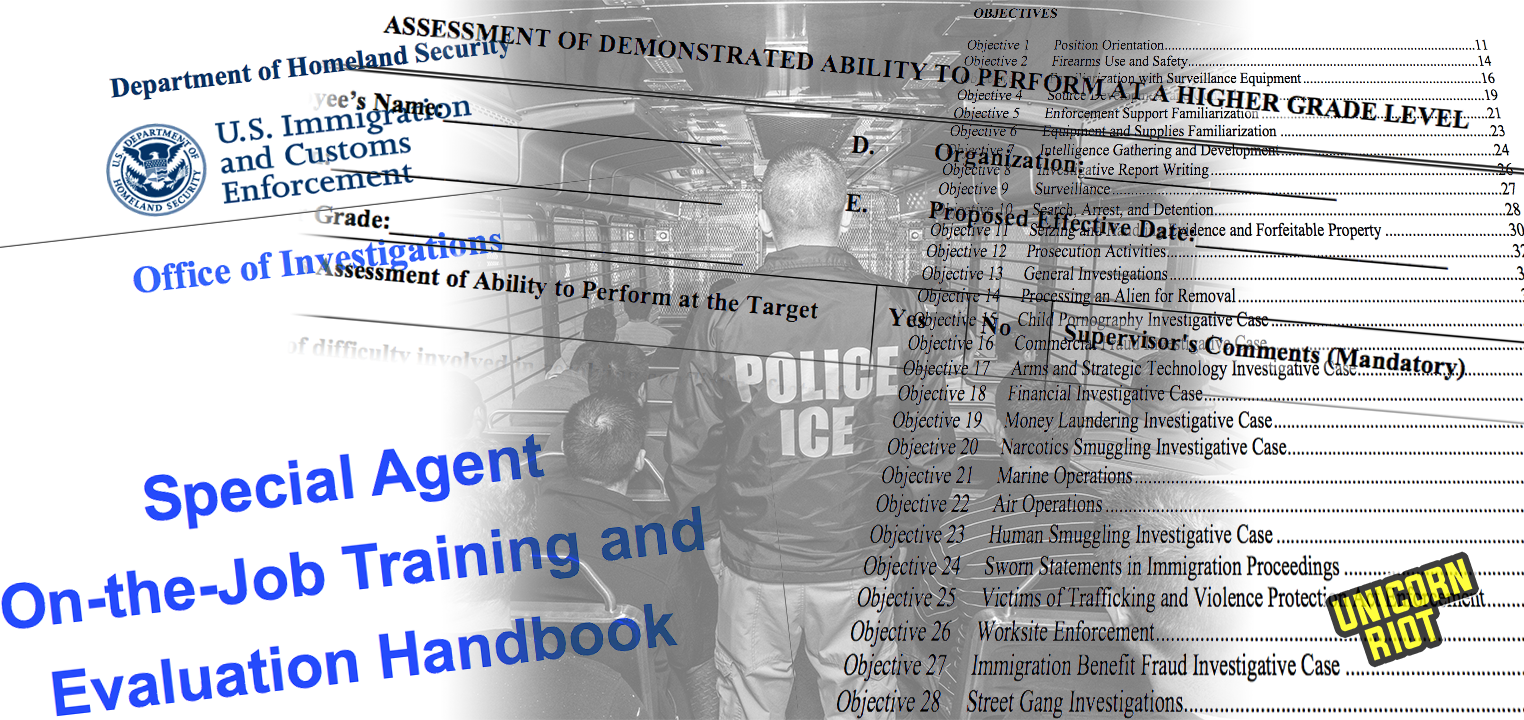Icebreaker Pt 4 – Homeland Security Special Agent On-the-Job Training Manual
Unicorn Riot obtained a series of Homeland Security Investigations policy manuals. Part 4 of the Icebreaker series of stories covers the 2008 version of the special agent training program, shedding light on the overall architecture of the Department of Homeland Security and how it instills doctrine in its investigators.
At 100 pages, marked OFFICIAL USE ONLY, the Special Agent On-The-Job Training and Evaluation Handbook dated 2/8/2008 is an extensive guide resembling a grade-school curriculum, and includes worksheets to grade and check-off skill development.
It is divided into sections of training doctrine for agents, after they leave the academy, to sharpen their skills at deporting people from the United States.
#Icebreaker Series - Unicorn Riot series on ICE policy manuals
- Icebreaker Pt 1 – Secret Homeland Security ICE/HSI Manual for Stripping US Citizenship (Feb. 14, 2018)
- Icebreaker Pt 2 – Confidential Homeland Security Asset Forfeiture and Search and Seizure Handbooks (Feb. 22, 2018)
- Icebreaker Pt 3 – Confidential Homeland Security Fugitive and Compliance Enforcement Handbooks (Feb. 28, 2018)
- Icebreaker Pt 4 – Homeland Security Special Agent On-the-Job Training Manual (Apr. 27, 2018)
- Icebreaker Pt 5 – Confidential Homeland Security Undercover Operations Handbook (Jun. 22, 2018)
- Icebreaker Pt 6 – Leaked ICE Special Response Team Handbook for Planning and Executing Armed Raids (Sept. 18, 2019)
- Icebreaker Pt 7 - ICE Case Management Handbook Based on Federal Law Enforcement "System of Systems” (Dec. 13, 2019)
- Icebreaker Pt 8 – Leaked ICE Handbooks for T and U Visa Application Investigations (Dec. 18, 2019)
- Icebreaker Pt 9 – Leaked Interrogation and Arrest ICE Manuals (Jan. 1, 2020)
- Icebreaker Pt 10 – Leaked ICE Agent Private Bill and Commercial Trade Fraud Investigation Handbooks (Jan. 4, 2020)
- Icebreaker Pt 11 – Bush/Clinton Era Customs Investigators Manuals (Feb. 13, 2020)
While acknowledging these manuals are authentic, ICE/HSI has refused to discuss them further, The Intercept reported on April 18th.
In related recent disclosures:
- On April 25th Reveal News reported that ICE isn’t following its own handbook on how to deport kids; the Juvenile and Family Residential Management Unit Field Office Juvenile Coordinator Handbook dated September 2017 was filed in a court case.
- On April 26th newly released documents showed how ICE mines police databases across the country, including using spotty and inconsistent local police data funneled through a portal called COPLINK to bring civil actions to deport alleged “gang members”.
The first level of training includes touring the office and gaining access to a set of federal investigative databases.
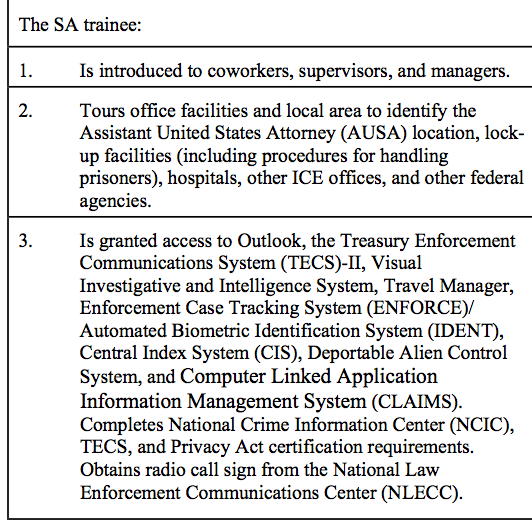
The training guide includes grading criteria for the trainee agent’s enthusiasm about the ICE agency mission itself:
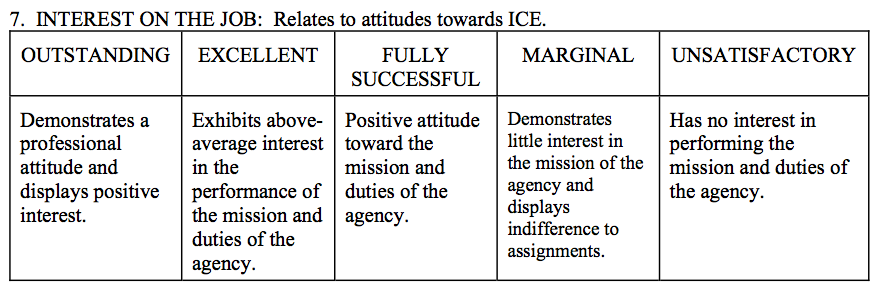
Agents in training are rated by grade levels.
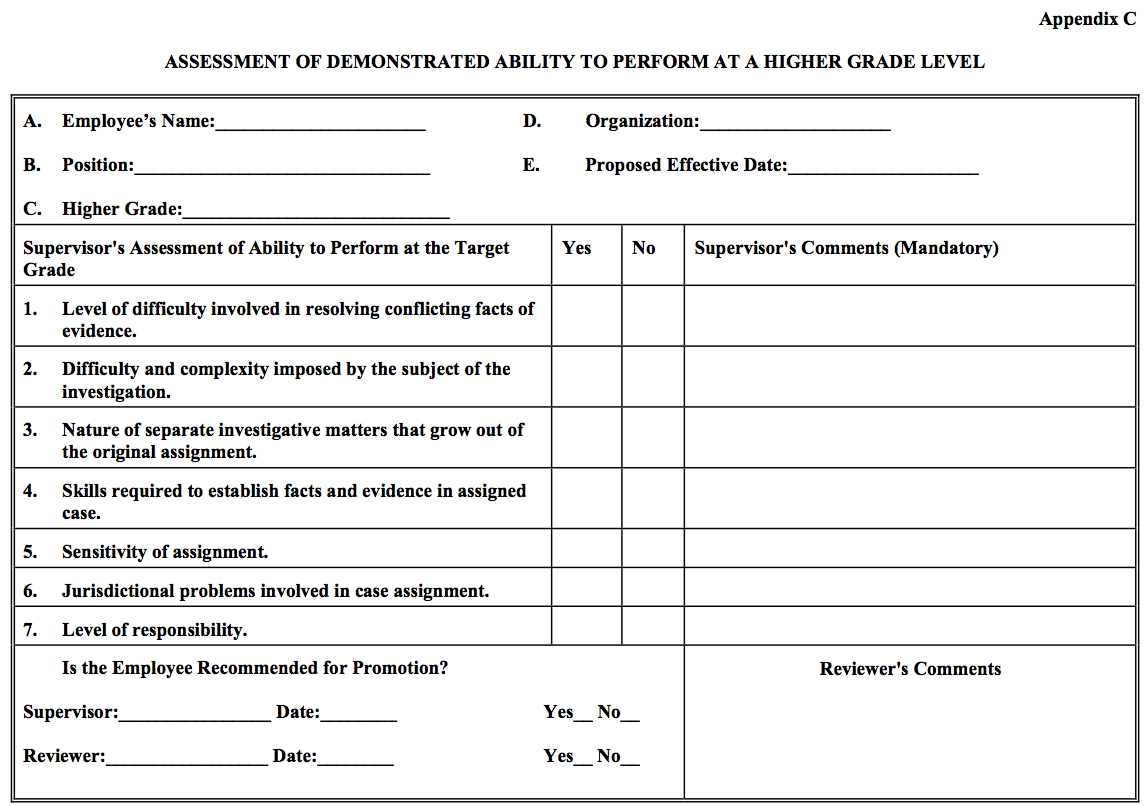
In the training doctrine, agents are directed to pursue what they label as street gangs, spy on them and attempt to set up deportations.
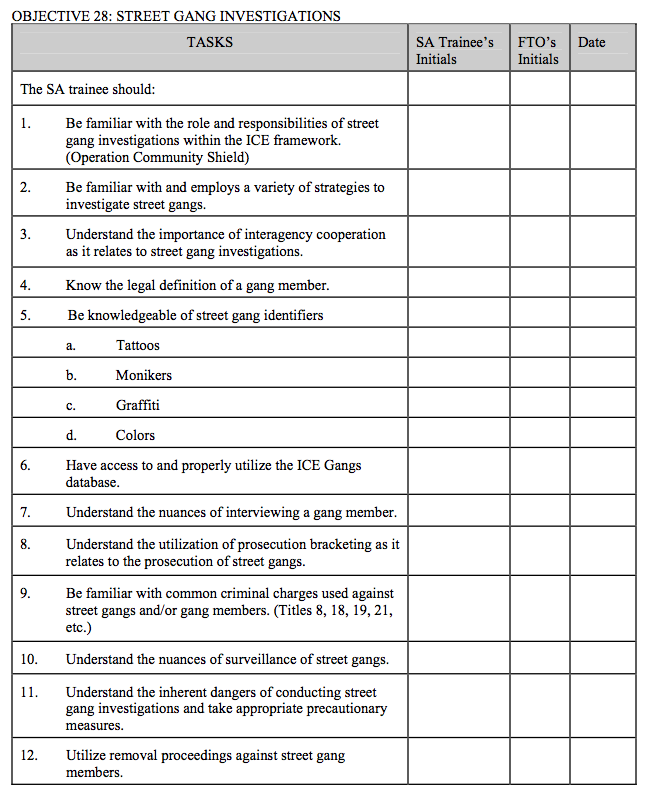
In Objective 23, building a human smuggling investigative case, tasks include “Develop and establish an informant pool, registering at least one informant,” as well as setting up an undercover operation: “Demonstrate a working knowledge of operations by explaining how to spot, stop, and apprehend an alien smuggling load.” In dehumanizing terminology, the agent is instructed to “Make arrangements for transporting the smuggling load to an ICE office.”
Unicorn Riot will continue to release ICE/HSI policy manuals in the Icebreaker series and we have submitted FOIA requests across the country in pursuit of a wide range of stories. You can support our work here. The rest of this article provides a page-by-page summary of this policy manual.
Special Agent On-the-Job Training and Evaluation Handbook
onthejob-trainingThe following notes are intended as a springboard to further research on the handbook. Page numbers (e.g. “p5”) are the numbers of the page as the PDF file has them numbered, not the numbers printed on the footer. Download the full PDF here.
The foreword says this handbook was released on February 8, 2008 as a successor to the US Customs Service (USCS) Office of Investigations training manual in 1990 and 2000. It is an entire federal agent training structure for multiple GS levels, divided into 29 “Objective” worksheets. Appendices and A through F style ratings for performance are detailed for every area of the service. Like most of the other material it is marked “Official Use Only”.
p5: This is part of a training program at ICE Academy and the Federal Law Enforcement Training Center (FLETC).
p6: This program “identifies SA trainees who are not suited for ICE law enforcement activities”.
p6: The program was rolled out in July 1990 under USCS, 1995 reorganization of USCS, 1999 new training office and 2003 creation of ICE. “The provisions of this Handbook are applicable to all Series 1811 managers, supervisors, Field Training Program Managers (FTPMs), FTOs, and SA trainees employed by ICE OI.”
p7: “SACs have the option of coordinating with any Department of Homeland Security (DHS) agency including, but not limited to U.S. Customs and Border Protection (CBP), specifically the Office of Field Operations (OFO) and the Office of Border Patrol (OBP), and U.S. Citizenship and Immigration Services (USCIS), and detailing SA trainees to those agencies to ensure familiarization of the SA trainees with operations that may impact investigations.” […] “The SAC [Special Agent in Charge] is responsible for all training within his or her area of responsibility (AOR),” […] “The SAC establishes the order in which Training Objectives 15 through 28 are to be accomplished”.
p8-9: Field Training Program Manager and Group Supervisor/RAC responsibilities.
p9-11: Field Training Officer (FTO) responsibilities.
p11: What the trainee is supposed to strive to do.
p12-14: General guidelines. How various parts can be skipped.
p15-17: Objective 1 includes getting introduced around the office and “granted access to Outlook, the Treasury Enforcement Communications System (TECS)-II, Visual Investigative and Intelligence System, Travel Manager, Enforcement Case Tracking System (ENFORCE)/ Automated Biometric Identification System (IDENT), Central Index System (CIS), Deportable Alien Control System, and Computer Linked Application Information Management System (CLAIMS). Completes National Crime Information Center (NCIC), TECS, and Privacy Act certification requirements. Obtains radio call sign from the National Law Enforcement Communications Center (NLECC).”
p18-19: Objective 2: Firearms and body armor.
p20-22: Objective 3: Familiarization with surveillance equipment: includes binoculars, night vision, cameras, tracking devices, tape recorders and radios, knows the electronic surveillance chapter of the Enforcement Handbook.
p23-24: Objective 4: Source development and control. Includes “Initiate the development and cultivation of an informant”, log receipts and “Articulate an understanding of how the forfeiture fund can be utilized to reimburse the office budget for certain
Purchases of Information (POI) and Purchases of Evidence (POE).” Also “Demonstrate a knowledge and understanding of ICE policy for the use of prisoners in criminal investigations.” “Verify and evaluate the information provided by an informant and transmit informant information to other agencies/offices through the Report of Investigation (ROI) in TECS-II.” The informant payout system: “Demonstrate the ability to prepare a CBP Form 4623, “Claim for and Award of Compensation for Original Information.””
p25-26: Objective 5: Enforcement Support Familiarization. Maintenance, activity logs, liason with local law enforcement, use maps and charts, “Demonstrate the ability to transmit using simplex (Tac) channels and repeater (Net) channels on an agency radio.”
p27: Objective 6: Signing out equipment and inventory, vehicle access.
p28-29: Objective 7: Intelligence gathering and development. Including “Smuggling patterns”, “Familiarization with, and the ability to, retrieve information from various source documents such as TECS, ROIs, Networked Law Enforcement Data Analysis System, etc.” Also “Demonstrate knowledge of ways in which Field Intelligence Groups (FIGs) and Intelligence Collection Analysis Teams collect, analyze, and disseminate tactical and operational intelligence, and be able to request assistance from the FIGs in support of an investigation.” Other services include Accurint and Lexis/Nexis.
p30: Objective 8: Investigative Report Writing. Microsoft Word to prepare Report of Investigation (ROI) into Case Management. Subpoenas, memos, complaints, affadavit to install a beeper/transponder.
p31: Objective 9: Surveillance. Plan and coordinate an operation, by foot and vehicle, with night vision, photo, video, telephonic equipment, and in surveillance vans.
p32-33: Objective 10: Search, arrest and detention. Includes searching vehicles, stash sites, cargo containers, garbage. Also executing search warrants and administrative vs criminal arrests.
p34-35: Objective 11: Seizing and handling evidence and forfeitable property. Handling evidence like vehicles contraband, baggage, currency, understanding the accountability for drug evidence, filing that paperwork.
p36-37: Objective 12: Prosecution activities. Prepare evidence for court and help US Attorneys with interviews and indictments. Show how to obtain a grand jury subpoena. Testify at arraignments, grand juries, at the trial and during immigration court. Appear in US District Court and participate ina proffer interview with defendant, defense counsel and prosecutor.
p38-42: Objective 13: General investigations. How to apply information from pen registers, and clandestine recorders, tracing property ownership, learn to work with international entities. Working on interviews of suspects and witnesses. Present cases to US attorneys. Know about subpoenas, customs summonses. Analyze phone toll records and real estate records. Install trap and trace. “The seven sensitive categories of individuals that require prior Department of Justice written approval before a consensual monitoring may take place.” Also “familiar with policies and procedures governing the asset sharing program” which divvies up the proceeds from asset forfeiture. Structuring a investigative case in TECS-II including ROI, SIR (Significant Activity Report), Incident Reports. Familiarity with Memorandums of Understanding (MOU) between agencies and special types of SIR reports. (see Pt 2 – Confidential Homeland Security Asset Forfeiture and Search and Seizure Handbooks for the asset forfeiture handling manual)
p43-45: Objective 14: Processing an alien for removal. Namely “encountering an alien, establishing “alienage and removability,” and completing the necessary paperwork pertinent to removal proceedings”. Includes “Creating an A-File”, “Processing an alien using IDENT/ENFORCE/TECS/SEACATS,” “Knowledge of juvenile detention standards,” “I-214, Warning as to Rights,” “I-213, Record of Deportable/Inadmissible Alien,” and a lot of other forms involving deporting people for not having some form of paperwork that counteracts the series of paperwork detailed here.
p46-47: Objective 15: Child pornography investigative case, covers looking for technical evidence and legal statutes
p48-52: Objective 16: Commercial fraud investigative case. Involving international trade and merchandise fraud, inspecting things at ports. A working knowledge of NAFTA, embargoes and other trade elements is required.
p53-54: Objective 17: Arms and strategic technology investigative case. The Arms Export Control Act, “Exodus case review procedures,” “Conduct a Project Shield America and a Project Gemini visit”.
p55-56: Objective 18: Financial investigative case. Knowing about bankers, thrift, currency, securities and commodities dealers, the Bank Secrecy Act, “bank draft, wire transfer, certificate of origin, and insurance certification.” Also “Understand the functions of the Asset Identification and Removal Groups,” which are part of the asset forfeiture revenue targeting teams.
p57-59: Objective 19: Money laundering investigative case. Jargon to know includes: Continuing Criminal Enterprise, Willful blindness, Fungible property, Enterprise. “The Black Market Peso Exchange technique of money laundering”. Also, “Demonstrate an understanding of the implications for money laundering investigations in the current applicable MOUs (including those between the former USCS and the FBI, U.S. Postal Service, and DEA which were made applicable by statute).”
p60-61: Objective 20: Narcotics smuggling investigative case. “Demonstrate an understanding of the MOU between DEA and ICE”. marine, air, vehicle, commercial smuggling and “Internal Conspiracy”. Also “Participate in a controlled delivery” and “Obtain a Federal Drug Identification Number from the El Paso Intelligence Center.” FDIN is a significant war on drugs database.
p62: Objective 21: Marine operations. Very simple “factors pertaining to the maritime community”.
p63: Objective 22: Air operations. “Knowledge of the Federal Aviation Administration and the type of assistance it can provide.”
p64-65: Objective 23: Human smuggling investigative case. “Develop and establish an informant pool, registering at least one informant.” Set up an undercover operation, “Demonstrate a working knowledge of operations by explaining how to spot, stop, and apprehend an alien smuggling load.” Humans are described as follows: “Make arrangements for transporting the smuggling load to an ICE office.” […] “Be familiar with current policies regarding parole/Employment Authorization Document/Deferred Action for informants and material witnesses.” […] “Be familiar with policies relating to alien smuggling controlled deliveries.”
p66-67: Objective 24: Sworn statements in immigration proceedings. “Identify and explain the difference between the statement forms: I-215B, I-215C, I-215W, I-263B, I-263C, I-263W, I-831, and I-263A.”
p68-70: Objective 25: Victims of trafficking and violence protection act. Proficiency in a law passed in 2000 about trafficking.
p71-72: Objective 26: Worksite enforcement. Includes “Taking several “complete” complaints from the general public about the alleged employment of unauthorized aliens within the United States.” Surveillance at worksites, a “business within Critical Infrastructure”, “cultivating a confidential informant for use during the course of a Worksite Enforcement investigation”. Also “Planning a Worksite Enforcement Operation, including coordinating the transportation and detention of apprehended aliens with the local DRO office.” (Note the recently uncovered COPLINK documentation shows how local police data can be automatically mined for worksite raids)
p73-79: Objective 27: Immigration benefit fraud investigative case. Hunting for evidence around various kinds of fraud and looking on forms “(i.e., I-140, DS-156E, DS-157, ETA 9035, I-129, I-360, ETA 750A/B, ETA 9089, etc).” for false information, conducting surveillance.
p80-81: Objective 28: Street gang investigations. “Operation Community Shield”. Interagency cooperation, the ICE Gangs database, “Utilize removal proceedings against street gang members.”
p82-84: Objective 29: Compliance enforcement investigations: Covers tracking immigrants through a lot of databases and case management systems, also “the ability to conduct proper deconfliction through inquiries with the local police department, U.S. Postal Inspection Service, and the Joint Terrorism Task Force (JTTF).” The “Terrorist Identities Datamart Environment Lookout” is also mentioned. Contacting schools, surveillance, searching garbage and attempting to get someone deported are all required. (See Pt 3 – Compliance Enforcement Handbook for the full policy manual)
p85-86: Appendix A: Blank sheet for extra tasks.
p87-89: Appendix B: Monthly scorecard for first two years of employment.
p90-94: Appendix C: Scorecard for assessment of ability to perform at higher grade level. GS-07, GS-09, GS-11, GS-12 levels covered for complexity of assignment.
p95-97: Appendix D: On-the-job program training maintenance schedule. The schedule of when the objectives get done.
p98-100: Appendix E: Two and a half pages o.f acronyms.
Please consider a tax-deductible donation to help sustain our horizontally-organized, non-profit media organization:

Unicorn Riot will continue the Icebreaker series with more confidential law enforcement manuals in the weeks to come. If you have information or comments to share about ICE either on the record or on background please contact [email protected] with “ICE” in the subject line.
#Icebreaker Series - Unicorn Riot series on ICE policy manuals
- Icebreaker Pt 1 – Secret Homeland Security ICE/HSI Manual for Stripping US Citizenship (Feb. 14, 2018)
- Icebreaker Pt 2 – Confidential Homeland Security Asset Forfeiture and Search and Seizure Handbooks (Feb. 22, 2018)
- Icebreaker Pt 3 – Confidential Homeland Security Fugitive and Compliance Enforcement Handbooks (Feb. 28, 2018)
- Icebreaker Pt 4 – Homeland Security Special Agent On-the-Job Training Manual (Apr. 27, 2018)
- Icebreaker Pt 5 – Confidential Homeland Security Undercover Operations Handbook (Jun. 22, 2018)
- Icebreaker Pt 6 – Leaked ICE Special Response Team Handbook for Planning and Executing Armed Raids (Sept. 18, 2019)
- Icebreaker Pt 7 - ICE Case Management Handbook Based on Federal Law Enforcement "System of Systems” (Dec. 13, 2019)
- Icebreaker Pt 8 – Leaked ICE Handbooks for T and U Visa Application Investigations (Dec. 18, 2019)
- Icebreaker Pt 9 – Leaked Interrogation and Arrest ICE Manuals (Jan. 1, 2020)
- Icebreaker Pt 10 – Leaked ICE Agent Private Bill and Commercial Trade Fraud Investigation Handbooks (Jan. 4, 2020)
- Icebreaker Pt 11 – Bush/Clinton Era Customs Investigators Manuals (Feb. 13, 2020)
